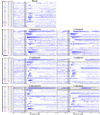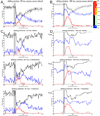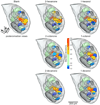A 4-dimensional representation of antennal lobe output based on an ensemble of characterized projection neurons
- PMID: 19464513
- PMCID: PMC2784994
- DOI: 10.1016/j.jneumeth.2009.03.019
A 4-dimensional representation of antennal lobe output based on an ensemble of characterized projection neurons
Abstract
A central problem facing studies of neural encoding in sensory systems is how to accurately quantify the extent of spatial and temporal responses. In this study, we take advantage of the relatively simple and stereotypic neural architecture found in invertebrates. We combine standard electrophysiological techniques, recently developed population analysis techniques, and novel anatomical methods to form an innovative 4-dimensional view of odor output representations in the antennal lobe of the moth Manduca sexta. This novel approach allows quantification of olfactory responses of characterized neurons with spike time resolution. Additionally, arbitrary integration windows can be used for comparisons with other methods such as imaging. By assigning statistical significance to changes in neuronal firing, this method can visualize activity across the entire antennal lobe. The resulting 4-dimensional representation of antennal lobe output complements imaging and multi-unit experiments yet provides a more comprehensive and accurate view of glomerular activation patterns in spike time resolution.
Figures










Similar articles
-
Ensemble response in mushroom body output neurons of the honey bee outpaces spatiotemporal odor processing two synapses earlier in the antennal lobe.PLoS One. 2012;7(11):e50322. doi: 10.1371/journal.pone.0050322. Epub 2012 Nov 29. PLoS One. 2012. PMID: 23209711 Free PMC article.
-
Localization of odor-induced oscillations in the bumblebee antennal lobe.Neurosci Lett. 2001 Dec 28;316(3):133-6. doi: 10.1016/s0304-3940(01)02385-0. Neurosci Lett. 2001. PMID: 11744220
-
Developmental changes in the density of ionic currents in antennal-lobe neurons of the sphinx moth, Manduca sexta.J Neurophysiol. 2002 Jun;87(6):2664-75. doi: 10.1152/jn.2002.87.6.2664. J Neurophysiol. 2002. PMID: 12037169
-
Glomerular interactions in olfactory processing channels of the antennal lobes.J Comp Physiol A Neuroethol Sens Neural Behav Physiol. 2013 Nov;199(11):929-46. doi: 10.1007/s00359-013-0842-6. Epub 2013 Jul 28. J Comp Physiol A Neuroethol Sens Neural Behav Physiol. 2013. PMID: 23893248 Free PMC article. Review.
-
The roles of local interneurons in the processing of olfactory information in the antennal lobes of the moth Manduca sexta.Acta Biol Hung. 1992;43(1-4):167-74. Acta Biol Hung. 1992. PMID: 1299109 Review.
Cited by
-
Description and Validation of Flow-Through Chambers of Respirometry for Measuring Gas Exchange in Animal Trials.Animals (Basel). 2023 Aug 19;13(16):2675. doi: 10.3390/ani13162675. Animals (Basel). 2023. PMID: 37627466 Free PMC article.
-
3D-Reconstructions and Virtual 4D-Visualization to Study Metamorphic Brain Development in the Sphinx Moth Manduca Sexta.Front Syst Neurosci. 2010 Mar 18;4:7. doi: 10.3389/fnsys.2010.00007. eCollection 2010. Front Syst Neurosci. 2010. PMID: 20339481 Free PMC article.
-
Ensemble response in mushroom body output neurons of the honey bee outpaces spatiotemporal odor processing two synapses earlier in the antennal lobe.PLoS One. 2012;7(11):e50322. doi: 10.1371/journal.pone.0050322. Epub 2012 Nov 29. PLoS One. 2012. PMID: 23209711 Free PMC article.
-
Digital, Three-dimensional Average Shaped Atlas of the Heliothis Virescens Brain with Integrated Gustatory and Olfactory Neurons.Front Syst Neurosci. 2009 Oct 26;3:14. doi: 10.3389/neuro.06.014.2009. eCollection 2009. Front Syst Neurosci. 2009. PMID: 19949481 Free PMC article.
-
Space Takes Time: Concentration Dependent Output Codes from Primary Olfactory Networks Rapidly Provide Additional Information at Defined Discrimination Thresholds.Front Cell Neurosci. 2016 Jan 14;9:515. doi: 10.3389/fncel.2015.00515. eCollection 2015. Front Cell Neurosci. 2016. PMID: 26834563 Free PMC article.
References
-
- Anton S, Hansson BS. Central processing of sex-pheromone, host odor, and oviposition deterrent information by interneurons in the antennal lobe of female Spodoptera littoralis (Lepidoptera, Noctuidae) J Comp Neurol. 1994;350:199–214. - PubMed
-
- Anton S, Homberg U. Antennal lobe structure. In: Hansson BS, editor. Insect olfaction. New York: Springer: Berlin; 1999. pp. 97–124.
-
- Berg BG, Galizia CG, Brandt R, Mustaparta H. Digital atlases of the antennal lobe in two species of tobacco budworm moths, the oriental Helicoverpa assulta (male) and the american Heliothis virescens (male and female) J Comp Neurol. 2002;446:123–134. - PubMed
-
- Boehm H, Schildberger K. Brain neurons involved in the control of walking in the cricket Gryllus bimaculatus. J Exp Biol. 1992;166:113–130.
Publication types
MeSH terms
Substances
Grants and funding
LinkOut - more resources
Full Text Sources

